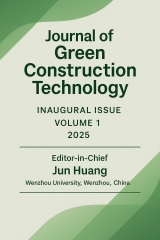About the Journal
Journal of Green Construction Technology is an interdisciplinary platform dedicated to cutting-edge research and practical innovations in sustainable building and construction. The journal promotes environmental stewardship, energy efficiency, and resource conservation, with a strong focus on circular economy strategies and low-carbon technologies.
It publishes Original Research Articles, Reviews, Short Communications, and Case Studies across a broad scope, including building-integrated photovoltaics (BIPV), biophilic design, climate-resilient infrastructure, recycled and biobased materials, 3D printing, self-healing technologies, and more.
Editor-in-Chief: Prof. Dr. Jun Huang (view profile)
Abbreviated key title: J. Green Constr. Technol.
Publisher: Zeal Press, UK
Access: Open Access
Aim & Scope:
Journal of Green Construction Technology aims to serve as a premier interdisciplinary platform for advanced research, innovation, and practical applications in green construction technologies. The journal is committed to foster sustainable development and materials circularity in the building and construction environment by promoting cutting-edge solutions and development integrating environmental stewardship, energy efficiency, and resource conservation.
Journal of Green Construction Technology covers a broad spectrum of topics related to green construction technologies and materials, with a focus on both fundamental research and applied innovations. The journal accepts submissions including Original Research Articles, Review Articles, Short Communications, Case Studies, etc.
The scope includes, but is not limited to, the following areas:
Building-integrated photovoltaics (BIPV).
Biophilic design and urban green spaces.
Climate-resilient infrastructure design for extreme weather events.
Circular economy strategies for construction waste reduction and materials reuse.
Carbon footprint quantification and mitigation in building and construction processes.
Geothermal heating/cooling systems.
Insulation materials.
Low-carbon, greenhouse gas emission alternatives.
Phase-change materials (PCM) for thermal energy storage, mitigation and management.
Recycled and biobased materials.
Self-healing materials and durability enhancement technologies.
Additive manufacturing/3D printing technologies.

